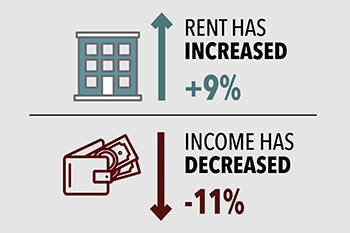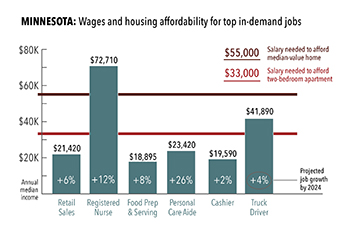From the Field: Minnesota Housing Partnership Releases First-Ever State of the State’s Housing Report
Apr 10, 2017
Minnesota housing advocates have made progress in recent years securing new affordable housing revenue from the state legislature (see Memo, 6/12/2013 and 5/30/2014), but the shortage of affordable housing may be growing faster than the resources needed to ensure a home for everyone. This dynamic is a primary focus of State of the State’s Housing, a research report released by Minnesota Housing Partnership (MHP), an NLIHC state partner. The report provides county-level and statewide data analysis and compares Minnesota’s housing market performance and shortages to those in other states.

There are several key takeaways from State of the State’s Housing. Minnesota continues to have the highest rates of racial disparity in homeownership of any state in the country; white Minnesotans are 37% more likely than people of color to own their homes, significantly higher than the national average of 25%. The percentage of low and moderate income households with cost burdens is increasing dramatically in Minnesota, with 546,213 families spending more than 30% of their income on rent in 2015. Median rents have increased by 9% over the past 15 years while median renter incomes have fallen by 11%. Over the same period, the percentage of households with cost burdens has risen by 30%, and in 2015 nearly half of Minnesota’s renters paid more than 30% of their incomes on their housing. State of the State’s Housing also reveals some positive trends, such as the 9% decline in homelessness from 2012 to 2015.

State of the State’s Housing examines data on trends and issues regarding rental housing, homeownership, senior housing, workforce housing options, and homelessness for each of the state’s seven regions. The report shows that the lack of affordability extends beyond the Twin Cities metropolitan area. Indeed, a shortage of workforce housing is stifling economic development in “Greater Minnesota,” the non-metro areas of the state where State of the State’s Housing shows that a lack of new construction has created a shortage of housing options even for people in relatively high-paying jobs. The problem is most severe, though, in the Twin Cities area where 60% of Minnesota’s cost burdened renters reside.
“The data in this report paints a clear and comprehensive picture of the growing affordability problem in Minnesota,” said Chip Halbach, executive director at MHP. “The findings of State of the State’s Housing will stand as a call to action to Minnesota legislators who are currently committing only .3% of the state’s annual budget to housing programs.”
For more information on State of the State’s Housing, contact Carolyn Szczepanski, director of communications and research at MHP, at [email protected].
Read State of the State’s Housing at http://bit.ly/2oMV5XQ.